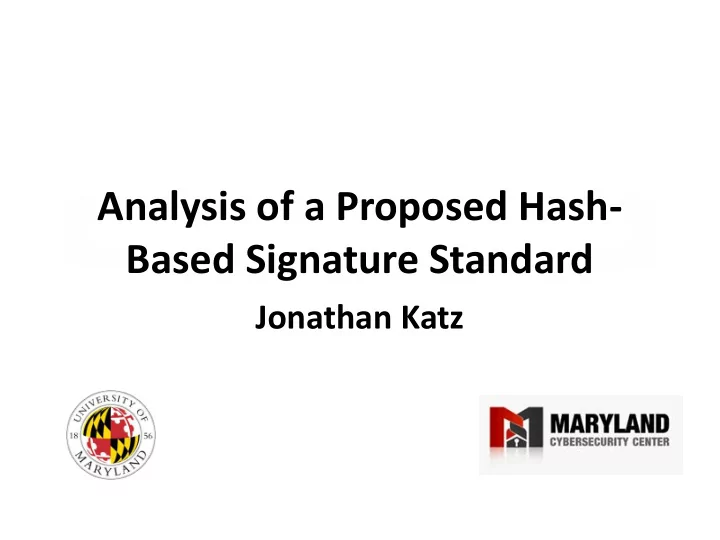

Analysis of a Proposed Hash- Based Signature Standard Jonathan Katz
Motivation and background • Recent interest in standardization of “post- quantum” public-key primitives • For signature schemes, several proposals based on cryptographic hash functions • We study the concrete security of two versions of an Internet Draft by McGrew and Curcio – …in the random-oracle model
McGrew-Curcio proposals (10,000-ft view) Merkle tree 1-time signature (stateful) many-time scheme [LDWM] signature scheme
McGrew-Curcio proposals (10,000-ft view) pk * pk 1 pk 2 pk N-1 pk N
Key observation • The scheme is composed of multiple instances of the 1-time scheme ⇒ Concrete security of the scheme (even in a single-user setting) depends on concrete security of the 1-time scheme in the multi-user setting
Multi-user security • [Bellare, Boldyreva, Micali], [Galbraith, Malone-Lee, Smart] • Attacker given N (independent) public keys – Succeeds if it can forge a signature with respect to any of them • If attacker can succeed with probability ≤ ε when attacking one scheme, can succeed with probability ≤ N· ε when attacking N schemes – Is a tighter reduction possible?
Our results • An initial version of the McGrew-Curcio draft (v02, 2014) has only a “loose” reduction – Because the 1-time scheme used has only a loose reduction in the multi-user setting • An updated version of the McGrew-Curcio draft (v04, 2016) has a tight reduction – Even in the multi-user setting
The LDWM 1-time scheme (v02)
Lamport’s scheme y 2,0 y 2,1 y n,0 y n,1 y 1,0 y 1,1 x 2,0 x 2,1 x n,0 x n,1 x 1,0 x 1,1 Sign(01…1) = x 1,0 , x 2,1 , …, x n,1
Improvement I y 2 y n y’ 1 y’ m y 1 x 2 x n x’ 1 x’ m x 1 Sign(01…1 checksum(01…1)) Sign(01…1) = x 2 , x n Signature length n + log n
Improvement II y n y’ 1 y’ m y 1 e x 1 x n x’ 1 x’ m Public key/signatures compressed by log e; signing/verification time increases by O(e)
“Trivial” improvements • Sign H(M) rather than M • Set pk = H(y 1 …y m ) instead of y 1 …y m
Security analysis? • Let q be the number of H-queries made by the attacker, and t be the output length of H • Forging a signature given pk 1 , …, pk N – Find M, M’ with H(M) = H(M’) Would like to avoid • Success probability O(q 2 /2 t ) birthday attack, also – Compute y * 1 =H e (x * 1 ), …, y * Q =H e (x * Q ) and find j, i 1 , …, i m such that pk j = H(y * i1 , …, y * im ) Loose security in the • Success probability O(qN/2 t ) – Find x * such that H e (x * )=y ij for some i, j multi-user setting! • Success probability O(qN/2 t )
Note… • Security of the many-time scheme (even in the single-user setting) cannot be better than multi-user security of the 1-time scheme
The LDWM 1-time scheme (v04)
Key ideas • Use domain separation so every invocation of H is on a distinct domain [Leighton, Micali] ⇒ Each H-query of the attacker can be “charged” to at most one step of key generation/signing • Per-key identifier/diversification factor to ensure domain separation for different keys ⇒ Each H-query of the attacker can be “charged” to ≤ 1 step of key generation for at most one public key • Use “salted” hash to prevent birthday attack
Domain separation y 2 y m y 1 2 x 2 m x m 1 x 1
Identifier/diversification factor • When keys are generated by multiple users – Identifiers can be based on users’ identities – Can also incorporate random values unlikely to repeat across (honest) users • When multiple keys are generated by one user – Identifier can be based on identity – Diversification factor can be based on sequence numbers to ensure distinctness
Security theorem • As long as identifiers/diversification factors are distinct across all keys, attacker’s success probability is at most 3q/2 t – Regardless of the number of keys! • Proof by case analysis and probabilistic arguments treating H as a random oracle
The many-time scheme (v04)
Key generation (high level) • Generate N keys for the 1 -time scheme – Using a distinct diversification factor each time • Construct a Merkle tree over those N keys – Ensuring domain separation at each node – Ensures that each H-query of the attacker can be “charged” to at most one node of the tree
Security theorem t • Attacker’s success probability is at most 3q/2 – Holds for multi-user setting as well
Summary • Signature scheme in an initial version of the McGrew-Curcio draft does not admit a tight security reduction – Since the underlying 1-time signature does not admit a tight reduction in the multi-user setting • Modified scheme in a later version of the draft does admit a tight security reduction to the underlying hash function – Even in the multi-user setting
Questions?
Recommend
More recommend